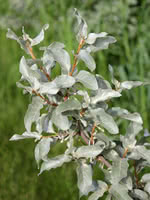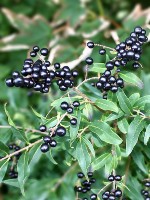Mon-Fri 9am - 5pm Mountain time
Silverberry (Wolf Willow) vs Wild Privet
Elaeagnus commutata
Ligustrum vulgare
NOT AVAILABLE THIS SEASON - MIGHT RETURN
Silverberry (also known as Wolf Willow) is a common native North American shrub. This beautiful ornamental plant has characteristic silver leaves and fragrant yellow flowers.
Its silver berries remain on the branches through the winter. Silverberry is cold hardy and has some ability as a nitrogen fixer. It can grow on dry to moist sandy/gravel soils. This plant is very low maintenance.
Wild Privet is a fast growing ornamental shrub that is well suited for forming hedges and privacy screens. It will retain its leaves in warmer climates but drops them in colder areas. They have small white flowers, though the smell is often considered unpleasant. While the berries are inedible, they are a good food source for many bird species.
It is recommended to prune Wild Privet immediately after flowering, as it can readily self seed. It is deer and rabbit tolerant. It can grow in dry areas, on slopes, and withstand the wind making it well suited for many growing conditions.
Silverberry (Wolf Willow) Quick Facts
Wild Privet Quick Facts
Toxicity: If ingested, all parts of this plant will cause severe discomfort. Toxic to dogs, cats, and horses

